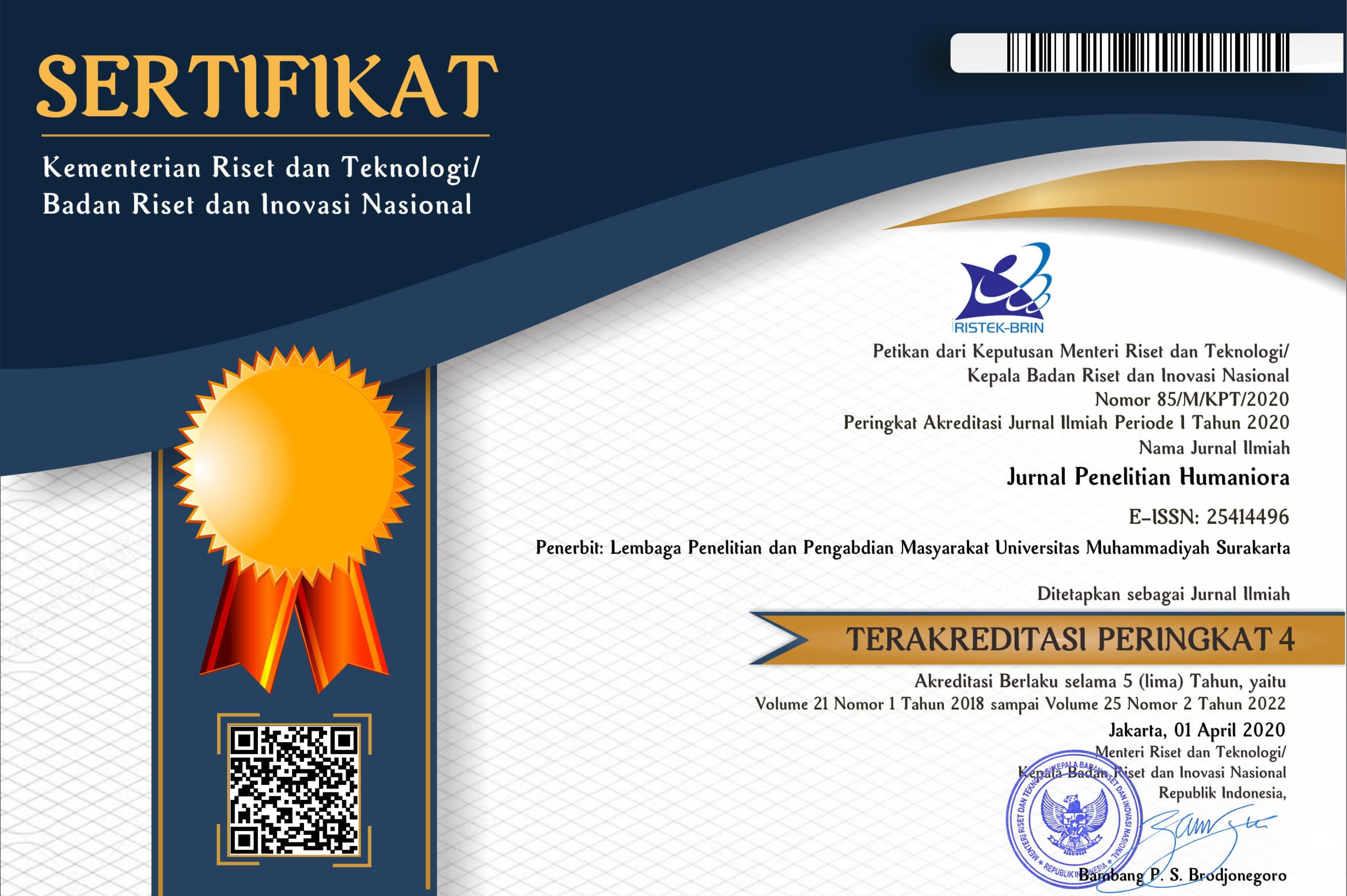TINDAK TUTUR ILOKUSI GURU BERLATAR BELAKANG BUDAYA JAWA: PERSPEKTIF GENDER
Ardina Kentary(1*), Abdul Ngalim(2), Harun Joko Prayitno(3)(1) Universitas Muhammadiyah Surakarta
(2) Universitas Muhammadiyah Surakarta
(3) Universitas Muhammadiyah Surakarta
(*) Corresponding Author
Abstract
This study aims at describing the shape of illocutionary speech acts Javanese cultural background of teachers in school, describing the strategies and techniques politeness Javanese cultural background of teachers in school, describing the use of illocutionary speech acts teachers’ Javanese cultural backgrund based on gender perspective. Attention method is used by writer to collect the data by providing several techniques, namely: involved refer-free conversation techniques, recording techniques, and notes technique. The analysis of data by using a padan method. Based on the analysis of data can be retrieved 3 conclusions. First, all categories of illocutionary speech acts by Searle are found in formal activities in this study. Meanwhile, in a non-formal activity found three categories. Second, in the formal and non-formal activities, the strategy used by teachers to speak are direct strategy and indirect strategy. The technique used are literal and non literal. In addition, there is a combination between speech strategies and speech techniques. Third, based on a gender perspective, there are three things that discused in this study. (a) in general, directive speech act is the dominant used in this research. The use of sub-utterances instructing, requesting, giving guidance, and advising in a formal activities are dominant by nGP than nGL. However, the sub-TTD to order the use of nGL is higher than nGP. In the non-formal activities, sub-utterances instructing is dominant used by nGL than nGP. (c) teacher’s Javanese cultural background prefer to choose literal technique in their speech. (d) the most dominant combination of strategies and techniques used is direct speech act strategie and literal speech act technique.
Keywords
Full Text:
PDFReferences
Bacha, Nahla Nola; Bahous, Rima; Diab, Rula L. 2012. “Gender and Politeness in a Foreign Language Academic Context” dalam International Journal of English Linguistics 2.1 (Feb 2012): 79-96 dalam http://proxy.library.ums.ac.id/nph-exec/00/http/search.proquest.com/diakses pada 19 Desember 2013.
Goddard, Angela and Lindsey Mean Patterson. 2000. Language and Gender. London and New York: Routledge.
Kunandar. 2011. Guru Profesional: Implementasi Kurikulum Satuan Tingkat Pendidikan (KTSP) dan Sukses dalam Sertifikasi Guru. Jakarta: PT Raja Grafindo Persada.
Leech, Geoffrey. 1993. Prinsip-Prinsip Pragmatik. Jakarta: UI-Press.
Mulyani. 2011. “Tidak Tutur Direktif Guru SMA Dalam Kegiatan Belajar Mengajar di Kelas: Kajian Pragmatik Dengan Perspektif Gender di SMA Kabupaten Ponorogo”. Disertasi. Surakarta: Program Pascasarjana UNS dalam http://pasca.uns.ac.id/ diakses pada 16
November 2013.
Musfah, Jejen. 2011. Peningkatan Kompetensi Guru: Melalui Pelatihan dan SUmber Belajar Teori dan Praktik. Jakarta: Kencana Prenada Media Group.
Prayitno, Harun Joko. 2009. “Tindak Tutur Direktif Pejabat dalam Peristiwa rapat Dinas: Kajian Sosiopragmatik Berperspektif Jender di Lingkungan Pemerintahan kota Surakarta”. Disertasi. Surakarta: Universitas Sebelas Maret Surakarta.
Prayitno, Joko Harun. 2011. Kesantunan Sosiopragmatik: Studi Pemakaian Tindak Direktif di Kalangan Andik SD Berbudaya Jawa. Surakarta: Muhammadiyah University Press.
Wijana,I Dewa Putu dan Muhammad Rohmadi. 2009. Analisis Wacana Pragmatik: Kajian Teori dan Analisis. Surakarta: Yuma Pustaka.
Yule, George. 2006. Pragmatik. Yogyakarta: Pustaka Pelajar.
Article Metrics
Abstract view(s): 2241 time(s)PDF: 2247 time(s)
Refbacks
- There are currently no refbacks.











